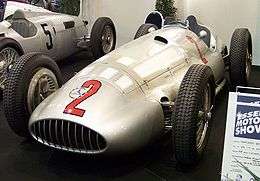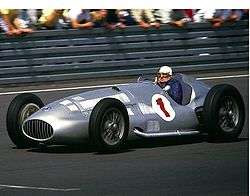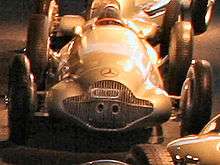Mercedes-Benz W154
 | |||||
| Category | Grand Prix | ||||
|---|---|---|---|---|---|
| Constructor | Mercedes-Benz | ||||
| Designer(s) |
Max Sailer Albert Heess Max Wagner Rudolf Uhlenhaut | ||||
| Predecessor | Mercedes-Benz W125 | ||||
| Technical specifications | |||||
| Chassis | Oval tubular frame | ||||
| Suspension (front) | Independent suspension with wishbones, coil springs, hydraulic dampers | ||||
| Suspension (rear) | De Dion axle, torsion bars, cockpit adjustable hydraulic dampers | ||||
| Engine | M154 & M163 3.0 litre V12 (60°) supercharged front-engine, longitudinally mounted | ||||
| Transmission | Mercedes-Benz 5-speed manual transmission ZF differential | ||||
| Weight |
980 kg (2,161 lb) (1938) 910 kg (2,006 lb) (1939) | ||||
| Tyres | Continental | ||||
| Competition history | |||||
| Notable entrants | Daimler-Benz AG | ||||
| Notable drivers |
Manfred von Brauchitsch Rudolf Caracciola Juan Manuel Fangio Karl Kling Hermann Lang Richard Seaman Lewis Hamilton | ||||
| Debut |
1938 Pau Grand Prix (non-championship) 1938 French Grand Prix (European Championship) | ||||
| |||||
| Drivers' Championships | 1[1] | ||||
The Mercedes-Benz W154 was a Grand Prix racing car designed by Rudolf Uhlenhaut. The W154 competed in the 1938 and 1939 Grand Prix seasons and was used by Rudolf Caracciola to win the 1938 European Championship.
The W154 was created as a result of a rule change by the sports governing body AIACR, which required supercharged engine capacities to be limited to 3000cc. Mercedes' previous car, the W125 used a 5700cc engine and was therefore ineligible to be entered. Mercedes decided that a new car, designed from the outset to comply with the new regulations would be preferable to modifying the existing car and thus designed the W154.
Although using the same chassis design as the 1938 car, a different body was used for the 1939 season and the M154 engine used during 1938 was replaced by the M163. As a result of the new engine, the 1939 car is often mistakenly referred to as a Mercedes-Benz W163.[2]
Concept
For the 1938 season, Grand Prix racing's governing body AIACR moved from a formula limited by weight to one limited by engine capacity. This meant Mercedes-Benz's previous car, the W125, was not eligible for entry into 1938 Grands Prix. When designing the new car, Mercedes based the chassis on that used in the W125. The new engine regulations allowed a maximum capacity of 3000cc with a supercharger or 4500cc without. After testing both types, Mercedes chose to use a supercharged 3000cc variant.
Chassis and suspension

The chassis was largely based on that of the preceding W125.[3] The frame was constructed using oval tubes made of nickel-chrome molybdenum to provide a stiff chassis.
The bodywork of the W125 was aluminium metal, which like its predecessors was left unpainted in its bare silver colour. This brought Mercedes' cars during this period, including the W154, the nickname of Silver Arrows.
The suspension was also near identical to the W125. The rear consisted of De Dion tube, a non-independent suspension designed to keep the two rear wheels in parallel using a solid tubular beam. The rear also had hydraulic rear dampers, which were possible to adjust from within the cockpit during a race.
Engine and transmission
 |
W154 start up
A W154 being started up and driven away at the Goodwood Festival of Speed in 2009. |
| Problems playing this file? See media help. | |
Due to the new regulations, a completely new engine was used for the 1938 season. The M154 was a 3000cc supercharged V12, attaining an output between 425-474 horse power. In 1939, the 2-stage supercharged version of this 2,961.54 cc V12 engine (67.0 x 70.0 mm) recorded a test bed power of 476 BHP (483 PS) at 7,800 rpm.
To compensate for the smaller engine compared to the W125, the W154 had an extra gear with a 5-speed manual transmission. The first gear was protected by a latch to avoid being engaged accidentally.
Racing history
1938

The W154 made its debut in the opening race of the 1938 season, the non-championship Pau Grand Prix in April. Two cars were entered, for Caracciola and Lang. Lang crashed during practice and the team withdrew his car, leaving Caracciola the lone W154 driver in the race. René Dreyfus took pole position in a Delahaye, but Caracciola was second and managed to beat Dreyfus away from the line at the start of the race. Despite leading the race, Caracciola was suffering from an old leg injury, and when he pitted for fuel he handed the car over to Lang. Dreyfus took the lead, but would not need to pit as his Delahaye's lower fuel consumption meant he could complete the race non-stop. Lang's car developed a spark plug problem and finished the race in second place, nearly two minutes behind Dreyfus' winning car. The car's next outing at Tripoli, again a non-championship race, was much more successful. The three cars that were entered for Lang, von Brauchitsch and Caracciola qualified first, second and third respectively. The gap from Caracciola to fourth placed Clemente Biondetti was over three seconds. The cars retained these positions at the end of the race and although von Brauchitsch and Caracciola had both suffered engine problems, Caracciola still finished over eight minutes ahead of fourth placed Raymond Sommer.[4][5]
The first race of the European Championship was the French Grand Prix, held at the Reims-Gueux circuit. Three cars were entered, for Caracciola, von Brauchitsch and Lang. A poor turnout meant that there were only nine competitors. Team manager Alfred Neubauer offered to enter a fourth W154 for Richard Seaman, but the organisers insisted on a maximum of three cars per team. Lang took pole position, with von Brauchitsch second and Caracciola third, ahead of the two Auto Unions of Christian Kautz and Rudolf Hasse. The Mercedes-Benz cars led from the start. After two laps, four cars had retired, leaving only the Mercedes-Benz and Talbot cars in the race, the Talbots already a minute behind. Lang had difficulties in a pit-stop and Caracciola's engine started firing on only eleven of its twelve cylinders. This left von Brauchitsch to claim victory ahead of Caracciola and Lang. The only other finisher was René Carrièrè in a Talbot, ten laps behind.[6]
Three weeks after the French Grand Prix came the second race of the European Championship, the German Grand Prix. Four W154s were entered and they took the first four positions on the starting grid; von Brauchitsch took pole position from Lang, Seaman and Caracciola. At the start, Lang took the lead but on lap three his car's spark plugs oiled up and he had to make an emergency pit stop. Shortly afterwards, team manager Alfred Neubauer brought Lang into the pits so that Walter Bäumer, a reserve driver for Mercedes-Benz, could take over. Lang's mechanical problems allowed von Brauchitsch to take the lead. Meanwhile, Caracciola had been struggling with abdominal pain and stopped on lap ten to allow Lang to take over his car. Von Brauchitsch came in for his second pit stop on lap sixteen, followed by Seaman in second position. During von Brauchitsch's pit stop, a mechanic spilt fuel over the car which was then ignited by a spark from the car's exhaust pipe. This allowed Seaman to exit the pits in the lead of the race. When his car's fire had been extinguished, von Brauchitsch also left the pits, only to crash his car later during the lap. Seaman continued on to win the race, followed by Lang in Caracciola's car. Lang's car, being driven by Bäumer, retired from the race with engine problems.[7]
Following the French Grand Prix, Mercedes-Benz travelled to Italy to contest two non-championship races - the Coppa Ciano at Montenero and the Coppa Acerbo at Pescara. For the Coppa Ciano, Caracciola was entered in an experimental car with a larger saddle tank and a shorter tail section. Pole position went to Carlo Felice Trossi in a Maserati 8CTF, but he retired on lap eight with engine troubles. Caracciola retired due to a punctured fuel tank, leaving von Brauchitsch to win from Lang. After the race, von Brauchitsch was disqualified for receiving outside assistance, which left Lang as the winner. At the Coppa Acerbo, Mercedes-Benz failed to win the pole position for the second race in a row; Tazio Nuvolari took pole position for Auto Union. In the race, Nuvolari retired when his differential broke, leaving Caracciola to win. The two other W154s of von Brauchitsch and Lang retired with engine problems. Lang's car caught fire after a conrod severed the fuel pipe to his car's engine; the fire burnt away all of the aluminium bodywork.[8][9]
1947-1957: Indianapolis 500

After the war, the W154 designated as chassis nine was discovered in Czechoslovakia. This was the car with which Lang had won the Coppa Ciano in 1938.[10] The car was sold to Don Lee, an American racing team owner. During 1938, the rules for the Indianapolis 500 were modified to allow the European Grand Prix cars to compete, and in 1947, Lee entered his W154 with Duke Nalon as the driver. Nalon discovered that Riley Brett, an Offenhauser mechanic, had obtained some Mercedes engine blueprints. Nalon was able to make copies and from these, the team was able to prepare the engine. The mechanics started the engine but left it running on idle which caused the fuel to condense in the engine manifold. Due to the engine being mounted at an angle, the rear cylinders filled up with fuel, breaking the conrods and one piston. A new piston was hastily sand cast in time for the race.[11]
Although Nalon set the second fastest qualifying speed, the qualifying system meant that he would start the race from 18th position. During the race, the replacement piston failed after 119 laps and the car had to retire from the race.[11]
Nalon was not rehired for the 1948 race. Ralph Hepburn was to be the driver, having not found a drive for the previous season's race. Hepburn later decided to instead drive a Novi for team owner Lew Welch. Meanwhile, one of Welch's drivers, Chet Miller, had decided that the Novi was too difficult to drive. Miller agreed to drive the W154 for Don Lee. He qualified the car in 19th position, but come the race, had to rely on a relief driver after 29 laps. Ken Fowler took over on lap 30 and he handed it over to Louis Tomei on lap 50. Tomei continued through to lap 108, when the car had to retire with oil problems.[11][12]
In 1949, Don Lee sold his W154 to Joel Thorne, another team owner. Thorne had the Mercedes engine removed and a Sparks straight-six engine installed. The car's bonnet no longer fit, so a new one had to be manufactured. Thorne drove the car himself, but failed to qualify for the race.[11][13]
Alfred Neubauer attended the 1949 race, in order to investigate the feasibility of a works Mercedes entry at Indianapolis. Neubauer studied Lew Welch's Novi team, and based on the information he had gained, Mercedes attempted to adapt the W154 for oval racing. The target was an entry in the 1951 Indianapolis 500. The cars were entered for two races in Argentina that year and attained two second-place finishes. However, Mercedes discontinued the programme.[11]
The ex-Don Lee W154 made one final appearance at Indianapolis in 1957. The car was now owned by Edward Shreve, and had a Jaguar straight-six engine fitted. Danny Kladis drove the car, but failed to qualify for the race.[11][14]
Complete results
Race results
European Championship results
|
Bold – Pole |
Non-championship results
† The Grand Prix class was run at the same time as the Voiturette class.[5]
* Fowler and Tomei were relief drivers for Miller. Miller drove laps 1-29, Fowler drove laps 30-50 and Tomei drove from 51-108, when the car retired.[12]
Hill climb results
| Year | Event | Venue | Driver | Result | Reference |
|---|---|---|---|---|---|
| 1939 | Höhenstraßen Rennen | Kahlenberg, Austria | Hermann Lang | 1 | [15] |
Notes
- ↑ The 1939 championship was not officially completed due to the outbreak of World War II. Although Auto Union driver Hermann Paul Müller lead the points standings, the German motorsport authority declared Mercedes driver Hermann Lang. As this is disputed, and the results of the championship were not officially announced, this championship has not been counted towards the total.
- ↑ Mercedes-Benz W154 (1939 body) (Grand Prix 3 Litre)
- ↑ Supercars.net: 1938 Mercedes-Benz W154
- ↑ Leif Snellman and Felix Muelas (2009-07-01). "Grand Prix de Pau". The Golden Era of Grand Prix Racing. Retrieved 2009-12-28.
- 1 2 Leif Snellman and Felix Muelas (2009-04-15). "XII° Gran Premio di Tripoli". The Golden Era of Grand Prix Racing. Retrieved 2009-12-28.
- ↑ Leif Snellman and Felix Muelas (2009-07-01). "XXIV Grand Prix de l'Automobile Club de France". The Golden Era of Grand Prix Racing. Retrieved 2009-12-29.
- ↑ Leif Snellman and Felix Muelas (2009-07-01). "XI Großer Preis von Deutschland". The Golden Era of Grand Prix Racing. Retrieved 2010-01-27.
- ↑ Leif Snellman and Felix Muelas (2010-01-10). "Coppa Ciano". The Golden Era of Grand Prix Racing. Retrieved 2010-02-01.
- ↑ Leif Snellman and Felix Muelas (2010-01-10). "Coppa Acerbo". The Golden Era of Grand Prix Racing. Retrieved 2010-02-01.
- ↑ Leif Snellman (2009-05-19). "CARS (PART 9) - Mercedes-Benz". The Golden Era of Grand Prix Racing. Retrieved 2009-12-26.
- 1 2 3 4 5 6 Henri Greuter (2009-09-22). "8W - What? - Penske-Mercedes PC23 500i". 8W. Retrieved 2009-12-26.
- 1 2 "1948 Championship Results: Indianapolis, IN 500 Mile Race - May 31, 1948" (PDF). Motorsport.com. 2000-01-12. Retrieved 2009-12-26.
- ↑ "1949 Championship Results: Indianapolis, IN 500 Mile Race - May 30, 1949" (PDF). Motorsport.com. 1999-11-29. Retrieved 2009-12-26.
- ↑ "1957 Championship Results: Indianapolis, IN 500 Mile Race - May 30, 1957" (PDF). Motorsport.com. 1999-11-09. Retrieved 2009-12-26.
- ↑ Nixon (1986), p. 266
References
|
External links
| Wikimedia Commons has media related to Mercedes-Benz W154. |
